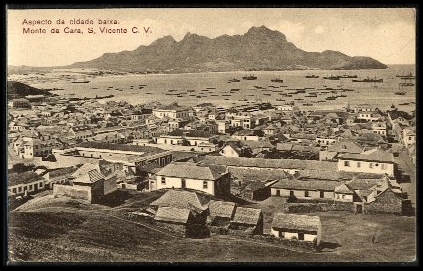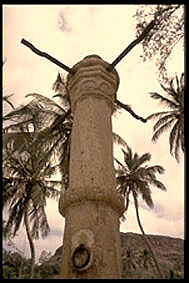|
Portuguese Cape Verde
Cape Verde was a colony of the Portuguese Empire from the initial settlement of the Cape Verde Islands in 1462 until the independence of Cape Verde in 1975. History 15th century The islands of Cape Verde were discovered in 1460-62 by Prince Henry the Navigator (Son of King John I) and Antonio Noli, in the service of Henry's relative King Afonso V. The southeastern islands, including the largest island Santiago, were discovered in 1460 by António de Noli and Diogo Gomes. The remaining northwestern islands São Nicolau, São Vicente and Santo Antão were discovered in 1461 or 1462 by Diogo Afonso.Valor simbólico do centro histórico da Praia Lourenço Conceição Gomes, Universidade Portucalense, 2008 There is no evidence of human settlement on Cape Verde prior to the arrival of the Portuguese. [...More Info...] [...Related Items...] OR: [Wikipedia] [Google] [Baidu] |
Portuguese Empire
The Portuguese Empire was a colonial empire that existed between 1415 and 1999. In conjunction with the Spanish Empire, it ushered in the European Age of Discovery. It achieved a global scale, controlling vast portions of the Americas, Africa and various islands in Asia and Oceania. It was one of the most powerful empires of the early modern period, while at its greatest extent in 1820, covering 5.5 million square km ( million square miles), making it among the List of largest empires, largest empires in history. Composed of colonialism, colonies, Factory (trading post)#Portuguese feitorias (c. 1445), factories, and later Territory#Overseas territory, overseas territories, it was the longest-lived colonial empire in history, from the conquest of Ceuta in North Africa in 1415 to the handover of Macau to China in 1999. The power and influence of the Kingdom of Portugal would eventually expand across the globe. In the wake of the Reconquista, Portuguese maritime exploration, Port ... [...More Info...] [...Related Items...] OR: [Wikipedia] [Google] [Baidu] |
Cape Verdean Escudo
The escudo (sign: ; ISO 4217: CVE) is the currency of the Republic of Cape Verde. One escudo is subdivided into one hundred ''centavos''. Amounts are generally written by using the () as the decimal separator, such as for 20 escudos, or for 1000. History The escudo became the currency of Cape Verde in 1914. It replaced the Cape Verdean real at a rate of 1000 = 1 escudo. Until 1930, Cape Verde used Portuguese coins, although banknotes were issued by the Banco Nacional Ultramarino specifically for Cape Verde beginning in 1865. Until independence in 1975, the Cape Verde escudo was equal to the Portuguese escudo. Subsequently, it depreciated, declining by about 30 per cent in 1977–78 and by a further 40 per cent in 1982–84. Thereafter, it remained fairly stable against the Portuguese escudo. In mid-1998 an agreement with Portugal established a pegged rate of 1 Portuguese escudo = 0.55 Cape Verdean escudos. Since the replacement of the Portuguese escudo with the euro, ... [...More Info...] [...Related Items...] OR: [Wikipedia] [Google] [Baidu] |
Cidade Velha
Cidade Velha (, Portuguese for "old city", also: ''Santiago de Cabo Verde'') is a cityCabo Verde, Statistical Yearbook 2015 Instituto Nacional de Estatística, p. 32-33 in the southern part of the island of , . Founded in 1462 by Portuguese traders, [...More Info...] [...Related Items...] OR: [Wikipedia] [Google] [Baidu] |
Diogo Afonso
Diogo Afonso (fl. 15th century) was a Portuguese explorer. Biography He took part in several explorations in the northwest and west coast of Africa which were made by Prince Henry. In 1444, he commanded a ship which had other explorers including Antão Gonçalves and Gomes Pires and explored the Rio de Oro (most of the areas that are now belong to Mauritania). In his second year, he took park in an expedition in the island of Arguin (now in Mauritania) with Antão Gonçalves and Garcia Homem. His ship passed by a frontier coast of the island, discovered its cape, in that region had a large number of captives, which were returned to Lisbon, where they were sold. Prince Henry. brought a fifth expedition which included Duarte Pacheco Pereira. He later explored the remainder of the Cape Verdean islands mainly in the northwestern part. On a royal map of Alphonso V dated 29 September 1462, the king brought it for Infante Don Fernando, his brother, of an island "Northwest of ... [...More Info...] [...Related Items...] OR: [Wikipedia] [Google] [Baidu] |
Santo Antão, Cape Verde
Santo Antão (Portuguese language, Portuguese for "Anthony the Great, Saint Anthony") is the northwesternmost island of Cape Verde. At , it is the largest of the Barlavento Islands group, and the second largest island of Cape Verde.Cabo Verde, Statistical Yearbook 2015 Instituto Nacional de Estatística (Cape Verde), Instituto Nacional de Estatística The nearest island is São Vicente, Cape Verde, São Vicente to the southeast, separated by the sea channel Canal de São Vicente. Its population was 38,200 in mid 2019,Instituto Nacional de Estatística, Cabo Verde (web). making it the fourth most populous island of Cape Verde after Santiago, Cape Verde, Santiago, São Vicente and Sal. Its largest city is Porto Novo, Cape Verde, Porto Novo located on the ... [...More Info...] [...Related Items...] OR: [Wikipedia] [Google] [Baidu] |
São Vicente, Cape Verde
São Vicente (Portuguese language, Portuguese for "Vincent of Saragossa, Saint Vincent") is one of the Barlavento Islands, the northern group within the Cape Verde archipelago in the Atlantic Ocean, off the West Africa, West African coast. It is located between the islands of Santo Antão, Cape Verde, Santo Antão and Santa Luzia, Cape Verde, Santa Luzia, with the Canal de São Vicente separating it from Santo Antão. Geography The island is roughly rectangle, rectangular in shape with an area of . From east to west it measures and from north to south .Cabo Verde, Statistical Yearbook 2015 Instituto Nacional de Estatística (Cape Verde), Instituto Nacional de Estatística The island, of volcano, volcanic origin, is fairly flat. The last volcanic activity is considered to have t ... [...More Info...] [...Related Items...] OR: [Wikipedia] [Google] [Baidu] |
São Nicolau, Cape Verde
São Nicolau (Portuguese language, Portuguese for ''Saint Nicholas'') is one of the Barlavento Islands, Barlavento (Windward) islands of Cape Verde. It is located between the islands of Santa Luzia, Cape Verde, Santa Luzia and Sal, Cape Verde, Sal. Its population is 12,424 (2015),Cabo Verde, Statistical Yearbook 2015 Instituto Nacional de Estatística (Cape Verde), Instituto Nacional de Estatística with an area of . The main towns are Ribeira Brava, Cape Verde, Ribeira Brava and Tarrafal de São Nicolau. History The island was discovered in 1461 or 1462 by Diogo Afonso, together with the islands of São Vicente, Cape Verde, São Vicente and Santo Antão, Cape Verde, Santo Antão.[...More Info...] [...Related Items...] OR: [Wikipedia] [Google] [Baidu] |
Diogo Gomes
Diogo Gomes () was a Portuguese navigator, explorer and writer. Diogo Gomes was a servant and explorer of Portuguese prince, Henry the Navigator. His memoirs were dictated late in his life to Martin Behaim. They are an invaluable (if sometimes inconsistent) account of the Portuguese discoveries under Prince Henry the Navigator, and one of the principal sources upon which historians of the era have drawn. He explored and ascended up the Gambia River in West Africa and discovered some of the Cape Verde islands. Early life Probably a native of Lagos, Portugal, Diogo Gomes began as page in the household of Prince Henry the Navigator and subsequently rose to the rank of ''cavaleiro'' (knight) by 1440. Diogo Gomes participated in the 1445 slave raid led by Lançarote de Freitas of Lagos on the Arguin banks, and claims to have personally captured 22 Berber slaves single-handedly.Chronicler Zurara, who relates the raids in some detail, does not seem to make notice of Diogo Gomes, ... [...More Info...] [...Related Items...] OR: [Wikipedia] [Google] [Baidu] |
António De Noli
Antonio de Noli (born 1415 or possibly 1419) was a 15th-century Genoese nobleman and navigator, and the first governor of the earliest European overseas colony in Subsaharan Africa. He discovered some of the Cape Verde islands on behalf of Henry the Navigator and was made the first Governor of Cape Verde by King Afonso V. In most history or geographic books, including ancient chronicles, or encyclopedias, he is referred as ''Antonio de Noli''. In Italy, he is known also as ''Antonio da Noli'' or sometimes as ''Antoniotto Usodimare''. Biography Antonio de Noli was born to a patrician family in Genoa, Italy, as referred in ancient sources of the epoch; e.g. Portuguese king's historian João de Barros stated already in 1552 that Antonio Noli was born in Genoa, and "of noble blood". Modern historians and researches also specify Antonio Noli as ''Genovese'' or ''Genoese'', e.g. Dumoriez (1762), Thomas (1860), Hamilton (1975), Diffie and Winius (1977), Irwin and Wilson (1999). It has ... [...More Info...] [...Related Items...] OR: [Wikipedia] [Google] [Baidu] |
Santiago, Cape Verde
Santiago (Portuguese language, Portuguese for “James, son of Zebedee, Saint James”) is the largest island of Cape Verde, its most important agricultural centre and home to half the nation's population. Part of the Sotavento Islands, it lies between the islands of Maio, Cape Verde, Maio ( to the east) and Fogo, Cape Verde, Fogo ( to the west). It was the first of the islands to be settled: the town of Ribeira Grande (now Cidade Velha and a UNESCO World Heritage Site) was founded in 1462. Santiago is home to the nation's capital city of Praia. History The eastern side of the nearby island of Fogo, Cape Verde, Fogo collapsed into the ocean 73,000 years ago, creating a tsunami high which struck Santiago. In 1460, António de Noli became the first to visit the island. Da Noli settled at ''Ribeira Grande'' (now Cidade Velha) with his family members and Portuguese from Algarve and Alentejo in 1462. [...More Info...] [...Related Items...] OR: [Wikipedia] [Google] [Baidu] |
Prince Henry The Navigator
Princy Henry of Portugal, Duke of Viseu (Portuguese language, Portuguese: ''Infante Dom (title), Dom Henrique''; 4 March 1394 – 13 November 1460), better known as Prince Henry the Navigator (), was a Infante of Portugal, Portuguese prince and a central figure in the early days of the Portuguese Empire and in the 15th-century European maritime exploration. Through his administrative direction, he is regarded as the main initiator of what would be known as the Age of Discovery. Henry was the fourth child of King John I of Portugal, who founded the House of Aviz. After procuring the new caravel ship, Henry was responsible for the early development of Portuguese exploration and maritime trade with other continents through the systematic exploration of Western Africa, the islands of the Atlantic Ocean, and the search for new routes. He encouraged his father to conquer Ceuta (1415), the Muslim port on the North African coast across the Straits of Gibraltar from the Iberian Peninsula. ... [...More Info...] [...Related Items...] OR: [Wikipedia] [Google] [Baidu] |
Colony
A colony is a territory subject to a form of foreign rule, which rules the territory and its indigenous peoples separated from the foreign rulers, the colonizer, and their ''metropole'' (or "mother country"). This separated rule was often organized into colonial empires, with their metropoles at their centers, making colonies neither annexation, annexed or even Territorial integration, integrated territories, nor client states. Particularly new imperialism and its colonialism advanced this separated rule and its lasting coloniality. Colonies were most often set up and colonized for exploitation and possibly settlement by colonists. The term colony originates from the ancient rome, ancient Roman , a type of Roman settlement. Derived from ''colonus'' (farmer, cultivator, planter, or settler), it carries with it the sense of 'farm' and 'landed estate'. Furthermore, the term was used to refer to the older Greek ''apoikia'' (), which were Greek colonisation, overseas settlements by ... [...More Info...] [...Related Items...] OR: [Wikipedia] [Google] [Baidu] |





